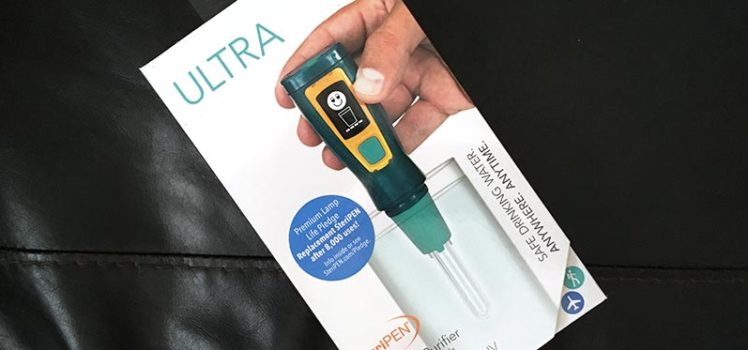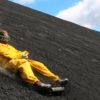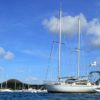Water: where to carry it all?

Before we went out for our daily training (fun) ride yesterday, Rebecca and I spent several hours sorting through our kit, as well as trying to figure out how we are going to carry everything. Aside from purchasing clothing – which we still need to do, because none of the clothes that we had on the boat are going to be at all appropriate – we have accumulated much of what we’ll require. The question is, where to fit everything on the bikes? Much like a Rubik’s Cube, this takes a bit of experimentation.
We had hoped to run a strictly bikepacking-type setup with bags made by Rogue Panda, but did consider the possibility that we may need a set or two of small panniers to supplement that. It’s for this reason that we asked Daniel to add a rear rack to our Tumbleweed bikes. Yesterday, we came to the realization that our laptop won’t fit in our framebag, so with that information, concluded that we will need a set of small panniers. Planning ahead, we had actually approached a couple of companies to see if they’d be interested in sponsoring us, in exchange for promotion on our site and social media, but we were turned down by both of them. As we were told by one of them, everyone has a blog these days. 🙂

One big puzzle to solve is how to carry all of the water that we will need. Just as in backpacking, water can be the heaviest thing that travelers need to carry. In some places there are enough streams that, with proper purification methods, it’s not necessary to carry liters upon liters of water. In other areas though, like Baja, MX for example, water is much less accessible. The Baja Divide website suggests that, at time, riders will need to carry 8-12L of water. That’s quite a bit! Most people seem to use a variety of water bottles, combined with water bladders. We do not yet have all this ironed out, but will soon.
We opted to purchase a USB-rechargeable Steripen for water treatment (pictured at top of post). Using ultraviolet light, the Steripen kills 99.9% of bacteria, viruses, and protozoa. That should keep us safe, but in case it dies, we also have a number of purification tablets as a backup.
On the training front, I am happy to report that things are progressing well. Each of our rides from here begins with a long and steady climb up the road. The first time we did that ride, 1 week ago, I was forced to stop multiple times to both catch my breath, and let the lactic acid drain from my legs. Yesterday I not only managed to climb all the way to the top of the hill without stopping, I completed the entire ride without a rest! I’m also happy to report that I haven’t felt a single twinge in my knee.





I have to admit I don’t think we could do it. Sticking to the back roads as much as possible, sleeping on the ground and camping day after day, week after week, month after month, hygiene issues, freeze dried food all or most of the time, knowing that much of the time you could be an hours long bike ride from the nearest anything…the list just seems to go on and on. Certainly we see the payoff, even so, the ROI appears marginal or, at least, a huge, HUGE amount of effort.
We sincerely wish the two of you the best in it. Hope it’s all you think it will be.
Time will tell. You’re right about all that stuff with the exception of the freeze-dried food. That stuff is expensive, and not the normal fare of long-term tourers.
It looks like it’s all coming together. A lifestraw with some coffee filters (pre-filter) is a good thing to have along for those cases where the only water is nasty. I always carry one in my survival pack when hiking and riding in the backcountry. They are small and lightweight but I know you’ve got very little space. I’m glad your legs and knees are holding up to the challenge.
Have fun!
Thanks, Javan.
Clothing, don’t over think that part. Every AT through hiker I ever met at the end of their 2000 mile hike, had two t–shirts, two shorts and one full pants, rain gear (poncho) and one heavy shirt/jacket/anorak.
Water…not sure about the southern routes you plan but a good theory to live by is…if you’re near water hydrate your body to the max and carry less if know you can easily make it to the next water source. Words of wisdom if you’re in mountainous regions.
I remember on my southbound AT hike the first 3 weeks, at every opportunity I sent BACK items I thought I wanted to carry and realised if I ever needed them, I could easily get them on the way.
You will adapt, on on.
All good advice.
http://woodenwidget.com/foldavan.htm
Pretty sure people wouldn’t be taking one of those on the trails that we’ve been riding. 🙂
Glad to hear that the knee is holding up!
Thanks, Tom. Me too.
You guys will figure it out.
My recommendations are that you put more weight over your rear wheel and less on your front wheel. Makes steering through life easier.
I live in Florida and only carry one bottle of water for a long bike ride. I get super hydrated first, and carry a bottle of almost frozen water. By the time I need it, it is still slightly chilled and drinkable. I quit carrying that second bottle of water because by the time I got to it, it was hot and horrible.
The guys at bumfuzzle.com stocked up on beer and toilet paper for their round the world sailing voyage because they were told of shortages based on what they read and they realized that was not the case. There are stores everywhere that pretty much
carry the basic necessities. Look at your overall trip and see how many days you will be away from them. It probably won’t be that many days.
You’re right, and with the internet, there is pretty good intel available about what is available, and where.
Be aware the pen only works if the water is pre-filtered to knock out larger, UV-resistant cysts and physical dirt. The filter should be something simple and washable. I imagine they have something in their literature.
Good kit, though.
I think a lot of people just use a buff or bandana to pre-filter the water.